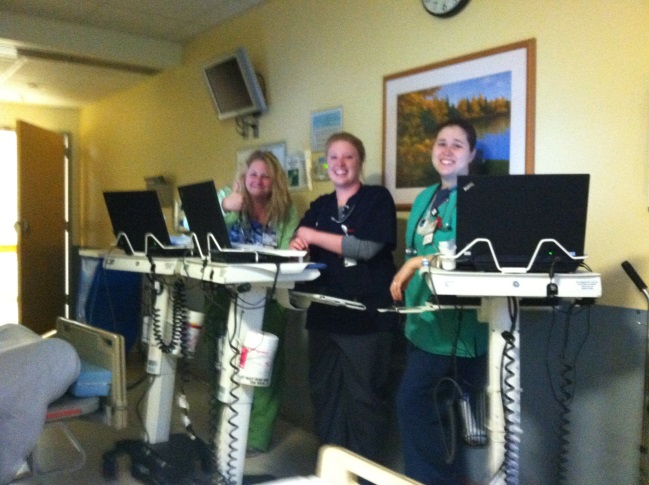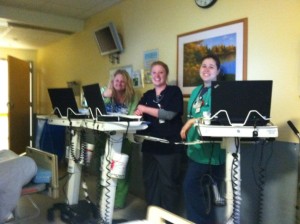
The bedside shift-to-shift nursing report isn’t new. It has been discussed as an effective patient engagement tool for at least 35 years. The Joint Commission identified communication failures during shift reports as a leading cause of sentinel events in the United States, and, in 2011, the National Patient Safety Foundation focused on the bedside report as a key patient safety strategy. Many health care organizations use it and use it well. Yet, as we see in so much of health care, widespread adoption hasn’t fully taken hold.
An Opportunity for Partnership
Historically, shift-to-shift nursing reports have taken place at a central nursing station or through voice-taping technology where the reports can be incomplete, incorrect, too long,
and/or beset by interruptions. However, moving shift reports to the bedside provides important opportunities for patient and family involvement, enabling them to contribute information, correct inaccuracies, ask questions and learn first-hand about their plan of care which can smooth the transition from hospital to home. Bedside shift reports can also provide heightened transparency in care delivery, demonstrate to patients and families that the care providers work together as a team, and strengthen relationships between nurses.
While on the surface these benefits seem clear, those who have tried to implement bedside shift reports have faced significant challenges. These include fear that report will take longer, concern about having to find a time when the patient is available and alert, reluctance to “let go” of the process, concerns about patient confidentiality and privacy (e.g., in semi-private rooms), misgivings about sharing information about problems such as ‘patient noncompliance’ in front of the patient, and sometimes cynicism about the value of patient and family involvement.
The Path to Transformation
In 2012, we initiated bedside nursing reports on the inpatient orthopaedic unit at Magee-Womens Hospital of UPMC in Pittsburgh, PA. While we faced many of the challenges noted, we were focused and committed to making this change and meeting the Joint Commission goals of improving communication among caregivers and encouraging patients’ active involvement in their own care as a patient safety strategy.
We developed a six-week strategy and tool kit to move from centralized and taped reports to bedside nursing shift reports. We prepared the nursing staff with an email introduction to bedside reports, sharing literature review results and relevant YouTube videos, and giving them an opportunity to ask questions and share concerns. We made it clear that this change was being made to improve patient safety, patient satisfaction and staff accountability. We also developed educational materials to provide to patients and families upon admission to acquaint them with the bedside reporting process and explain their roles.
Our 6-Step Bedside Nurse Report Checklist
- Introduce the on-coming nurse to patients and family members (if the patients wants the family members present).
- Review S-ituation, B-ackground, A-ssessment and R-ecommendations.
- Conduct a patient safety check (ID band, incision, IV site, PCA settings, drains/foley, fall risk).
- Check the environment for safety (call bell, walker in reach, bed alarm).
- Update white board with name/phone number.
- Ask patient (and family) if they have anything to add or have questions.
Moving the HCAHPS Needle
Since implementation in 2012, our HCAHPS scores have improved as follows:
| Indicator | Jan-Sept 2012(379 responses) | Sept-Dec 2012(159 responses) | Jan-March 2013(112 responses) | Apr-June 2013(117 responses) | July-Sept 2013(134 responses) | Oct-Dec 2013(130 responses) |
| Communication with nurses | 80 | 81 | 87 | 89 | 87 | 86 |
| Nurses treat you with courtesy/respect | 85 | 88 | 91 | 89 | 90 | 91 |
| Nurses listen carefully to you | 74 | 73 | 85 | 79 | 84 | 84 |
| Nurses explain in a way you can understand | 81 | 82 | 86 | 82 | 87 | 82 |
| Pain | 74 | 74 | 82 | 76 | 76 | 83 |
Moving forward, we are focusing on improving communication between nurses on the inpatient unit and the staff of the Post-Anesthesia Care Unit (i.e. Recovery Room). We have been using FaceTime® via iPAD® to do the report between the two units which has been working well, and we are comparing the use of FaceTime with other technologies as well.
A Triumph for Patient-Centered Care and Safety
Bedside shift-to-shift nursing reports acknowledge patients and families as full partners, build trust in the care process, demonstrate teamwork among the staff, and help put patients’ minds at ease that the care team knows what’s “going on with them.” The bedside report is one more way to improve patient centeredness – treating patients and families with dignity and respect, sharing information, inviting involvement and pursuing collaboration. More so, bedside nursing reports provide the opportunity to improve patient safety.

Jim Malkowiak, RN, BSN

Katie McConnell, RN, MS
For more information about our initiative or our implementation toolkit, please contact us at malkowiakjj@mail.magee.edu or kochka@mail.magee.edu.







1 Comment
Congratulations to the UPMC team! Fantastic article, totally in line with AHRQ’s recommendations. Your initiative, toolkit and patient satisfaction results are to be applauded! Kudos. John King, President Standard Register Healthcare